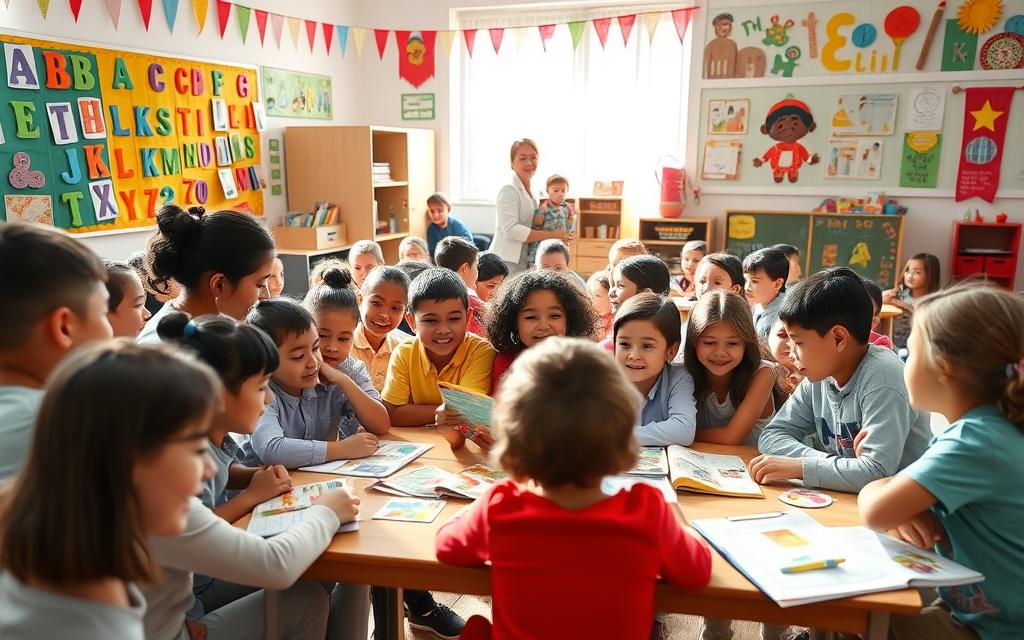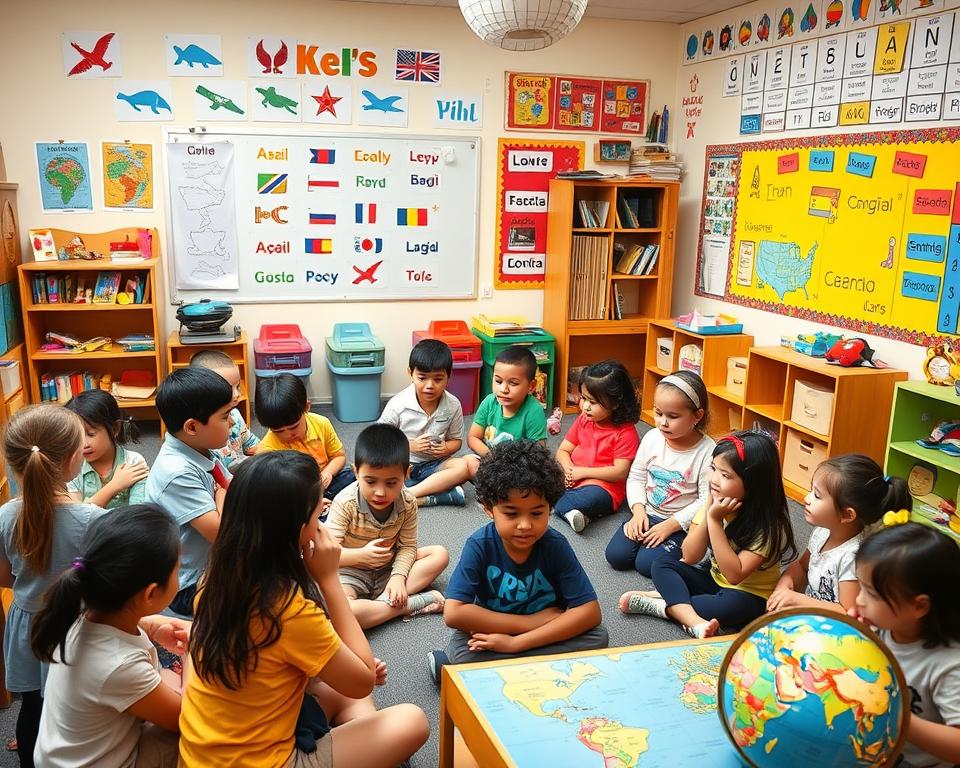More than 5 million children in U.S. schools are classified as English language learners, according to the Department of Education. This number shows how crucial it is to teach ESL well to primary students. Teaching ESL for primary students needs a special method. It should include primary school ESL instruction and a detailed ESL curriculum for kids.
By using methods like the Picture Word Inductive Model, teachers can make learning fun and supportive. This helps kids grow their language skills and understand different cultures.
Understand the Primary ESL Student’s Mind
Teaching English as a second language to primary students requires a deep understanding of their minds. It’s important to know their cognitive development stages and common learning patterns. Also, cultural sensitivity in the classroom is key. By using best practices for teaching esl to kids, teachers can make a supportive learning space. This space helps students succeed academically.
Studies show that effective strategies for teaching esl to primary students are crucial. Techniques like scaffolding, visual aids, and strategies to remember vocabulary are important. For example, graphic organizers like K-W-L charts help teachers see what students already know. Pre-teaching important concepts also helps students understand grade-level texts better.
Using relatable texts and quotes from books can make learning more engaging for ESL students. This approach boosts their understanding and interest in the material.
- Providing slower speech and pauses to aid processing of new information
- Utilizing language buddies to support new ESL students’ adjustment
- Focusing on the most crucial vocabulary words to teach, with a limited number of new terms per lesson
- Accessing background knowledge to improve lesson comprehension and cultural responsiveness
Why ESL Teaching is Crucial for Primary Students
Early Language Acquisition
Young children have a natural ability to absorb new languages quickly, making primary school an ideal time to introduce ESL.
Cognitive and Social Benefits
Learning a second language improves cognitive flexibility, enhances problem-solving skills, and promotes cross-cultural understanding.
Academic Readiness
Strong English skills help primary students excel academically, especially in bilingual or English-speaking environments.
Cognitive Development Stages in Language Learning
It’s vital to understand the cognitive development stages of primary ESL students. This means recognizing their language and literacy skills. It also involves knowing their individual experiences and cultural backgrounds. This knowledge helps teachers tailor their teaching to meet each student’s needs.
Essential Components of Teaching ESL to Primary Students
Teaching ESL to primary students requires a fun and interactive classroom. Fun activities for esl primary classes make learning exciting. Visual aids like graphs and charts help students who find language hard.
Interactive esl lessons for young learners include group work. This helps students learn together through activities like Think-Pair-Share.
Some key strategies for teaching ESL to primary students include:
- Identifying both content objectives and language objectives
- Using scaffolding strategies like graphic organizers and realia to help students access content
- Providing opportunities for peer review and cooperative learning
- Differentiating classroom activities to cater to varying levels of English proficiency
By using these strategies and fun activities for esl primary classes and interactive esl lessons for young learners, teachers can create a supportive environment. This helps primary students reach their full potential.
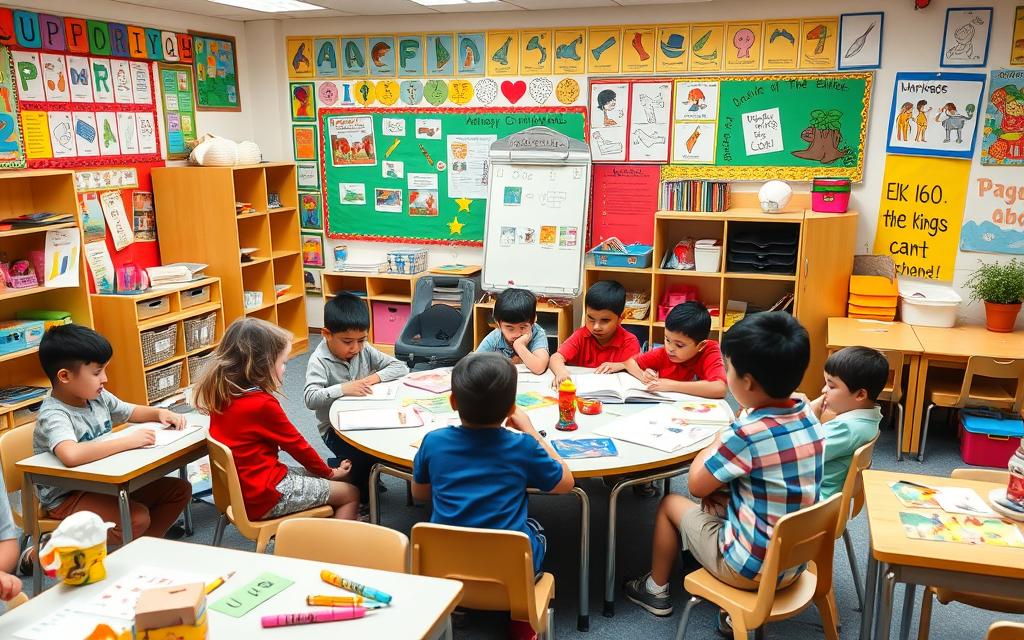
Research shows that effective ESL instruction boosts academic achievement. Interactive esl lessons for young learners are key to this. By making learning fun, teachers help students build a strong English foundation. This prepares them for future success.
Create an Engaging ESL Learning Environment
Teaching English to primary school students requires a fun and engaging classroom. Using engaging esl resources for elementary students and esl lesson plans for primary school is key. A well-designed classroom boosts language learning and keeps students interested.
To make a classroom engaging, create a supportive atmosphere. Visual aids and chances to practice English are also important. Studies show that students do better and stay motivated in supportive environments. With the right engaging esl resources for elementary students and esl lesson plans for primary school, learning can be both enjoyable and effective.
Physical Classroom Setup Tips
A tidy classroom helps students learn and stay focused. Label objects in English and the students’ home languages. Also, display materials in many languages to make everyone feel included.
Building a Supportive Atmosphere
Getting to know students is crucial for a supportive classroom. Teachers should learn about students’ strengths and interests. This way, students feel comfortable practicing their English in a safe space. Using engaging esl resources for elementary students and esl lesson plans for primary school helps create a supportive and engaging classroom.
Interactive Methods for Vocabulary Building
Teaching ESL to young learners can be made easier with innovative approaches. Interactive methods are great for building vocabulary. They make learning fun and engaging. Studies show games can boost vocabulary retention by up to 30% compared to old teaching ways.
Interactive methods include sentence frames, Bingo games, and songs with movement. These help students learn in a relaxed way. About 70% of students enjoy learning more when it’s fun and interactive.
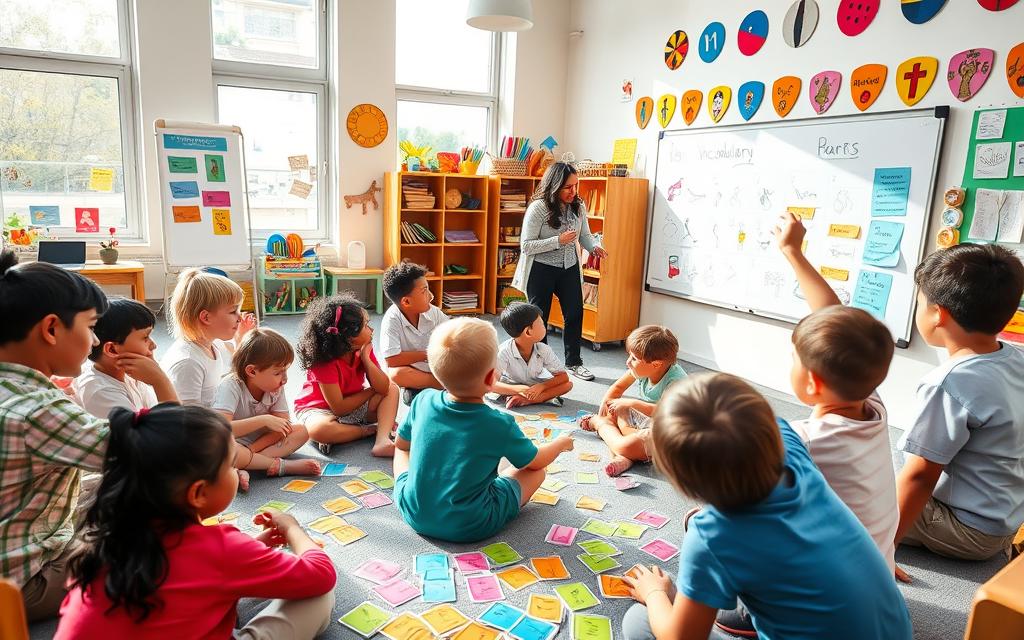
Using real-life objects and visual aids also helps. They make learning more interesting and interactive. By using innovative approaches to teaching ESL to young learners, teachers can make learning fun and effective.
- Games and interactive activities can increase vocabulary retention by up to 30%
- Approximately 70% of students are more likely to participate in lessons that incorporate fun and interactive games
- Using real-life objects and visual aids can support effective vocabulary presentation and increase student engagement
Incorporate Movement and TPR in ESL Lessons
Teaching ESL to primary students can be made easier with movement and Total Physical Response (TPR). TPR uses physical actions to help learn language. It’s great for young learners because it links words to actions, making them easier to remember.
Studies show TPR boosts long-term memory of words and phrases. It also makes students more eager to join in, thanks to their love for moving. For example, saying “open your book” and then doing it helps avoid confusion in class.
Some fun TPR activities for primary school ESL include action-based learning activities like “Simon Says” and “TPR Circles.” These games help students stay focused and learn language better. Songs like “Cha Cha Slide” that get students moving can also teach new words and grammar.
Action-Based Learning Activities
- Simon Says: a classic game that promotes active participation and focus on following directions
- TPR Circles: an activity that involves students being eliminated and standing behind the teacher as they observe actions
- TPR Sounds: an approach that integrates sounds with actions to enhance the connection between vocabulary and physical movement
Adding movement and TPR to ESL lessons makes learning fun and interactive. It boosts student motivation and helps them feel more comfortable with language. This approach also makes learning a positive experience.
Digital Tools and Resources for Primary ESL Classes
Teaching ESL to young learners can be greatly enhanced by digital tools and resources. A good esl curriculum for young learners should mix fun and learning. Technology helps make learning fun and easy for students.
Using apps and online materials is a great way to teach ESL to kids. For example, Duolingo offers ESL courses in over 20 languages. Newsela has current events articles in different reading levels. These tools help make learning fun and engaging.
Utilizing Digital Resources
There are many digital tools to support language learning. These include:
- Tablet computers and mobile technologies to foster learner autonomy
- Online platforms like Kahoot! and BBC Teach for interactive lessons
- YouTube Education for curated educational content
- Google Classroom and Microsoft Teams for virtual classrooms and collaboration
By using these tools, teachers can make learning more fun and effective. This helps improve the esl curriculum for young learners and supports best practices for teaching esl to kids.

Assessment Strategies for Young ESL Learners
Assessing young ESL learners requires effective strategies for teaching esl to primary students. It’s important to tailor the approach, as a one-size-fits-all method doesn’t work. Assessment as learning helps learners assess themselves and their peers, promoting equality in language and culture.
Some effective strategies for assessing young ESL learners include:
- Using rubrics to provide a consistent grading criterion
- Conducting student conferences for personalized feedback
- Implementing portfolio assessments to track student learning over time
- Utilizing performance-based assessments to demonstrate learned concepts in real-world scenarios
Research shows that assessments that include student views and encourage their agency boost engagement. It’s vital to monitor student progress regularly. Educators must balance assessments that check both content knowledge and language skills. By using these effective strategies for teaching esl to primary students, educators can create a supportive and inclusive learning space for young ESL learners.
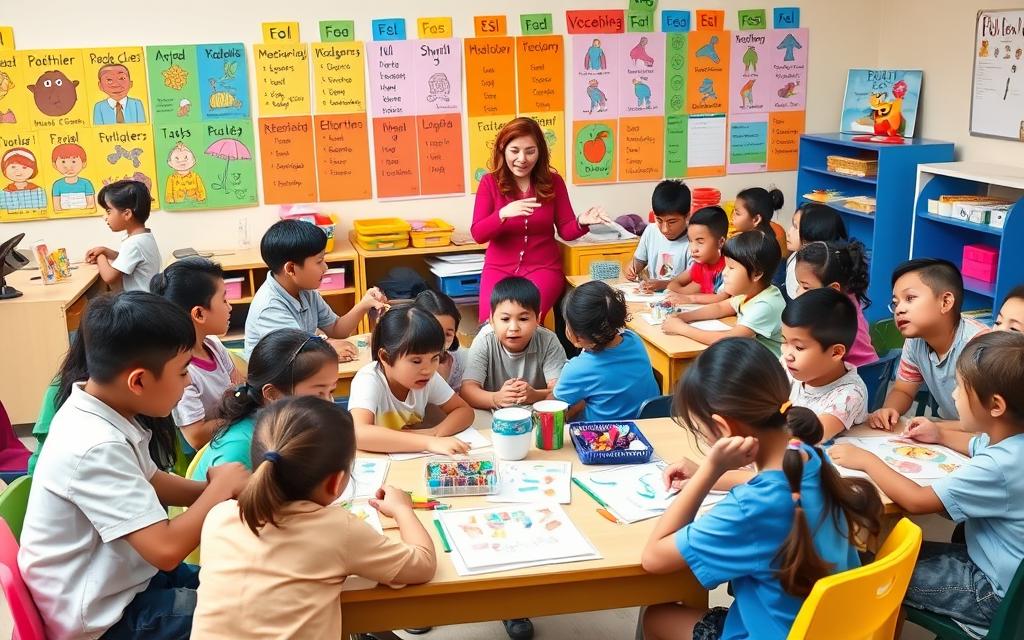
Overcoming Common Challenges in Primary ESL Education
Teaching English as a second language to primary students is rewarding but comes with challenges. Managing mixed ability classes is a big one. Students have different language skills. To tackle this, using fun activities for esl primary classes that fit various learning styles and abilities is key.
Keeping students engaged is another hurdle. Interactive esl lessons for young learners are vital. They include games, role-plays, and activities that boost language practice and interaction.
Addressing Language Anxiety
Language anxiety is a big problem for ESL students. It stops them from speaking well. To beat this, create a supportive learning space. Encourage students to try new things and make mistakes.
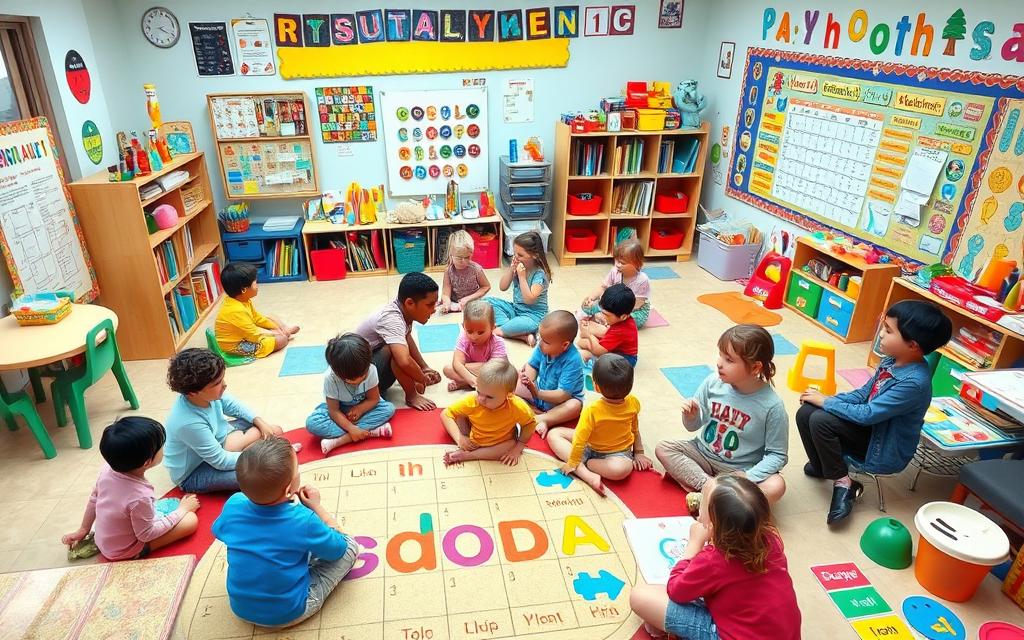
Maintain Student Engagement
To keep students hooked, try different approaches. Here are a few:
- Give students chances to practice their language in a safe way
- Use pictures and videos to help them learn
- Add games and activities that make learning fun and interactive
These methods help create a fun and supportive learning space. They help students face common ESL challenges and reach their language goals.
Implement Effective ESL Teaching Strategies
As more students learn English in primary schools, it’s vital to use the right methods. Teachers need to make a welcoming and fun space. This helps students learn English and love learning more.
Studies show that ELLs need chances to practice English without stress. Using that includes writing, speaking, drawing, and listening helps them understand better. The SWIRL framework is also helpful for ESL teachers in primary schools.
Teachers can make ELLs feel valued and at ease by planning carefully and engaging them well. With patience and creativity, teachers can help their students reach their full potential.
Strategies for Teaching ESL to Primary Students
1. Use Visual Aids
Incorporate pictures, flashcards, and videos to make lessons more engaging and easier to understand.
2. Incorporate Songs and Rhymes
Songs and nursery rhymes are excellent tools for teaching pronunciation, rhythm, and vocabulary.
3. Focus on Basic Vocabulary
Start with everyday words and phrases that are relevant to students’ daily lives.
4. Encourage Repetition
Repetition helps young learners reinforce their understanding and retain new information.
5. Use Total Physical Response (TPR)
Combine language with physical movement to create a multisensory learning experience.
6. Create a Positive Environment
Praise efforts and create a supportive atmosphere to boost confidence and motivation.
20 Classroom Activities for Teaching ESL
1. Flashcard Games
Use flashcards for matching, memory, and vocabulary drills.
2. Role-Playing
Engage students in role-playing scenarios such as ordering food or shopping.
3. Interactive Storytime
Pause during story readings to ask questions and discuss the plot.
4. Show and Tell
Encourage students to describe their favorite items in English.
5. Word Bingo
Create bingo cards with vocabulary words.
6. Simon Says
Use this classic game to teach action verbs and instructions.
7. Alphabet Treasure Hunt
Hide objects that start with different letters around the room.
8. Picture Description
Ask students to describe pictures in detail.
9. Group Story Creation
Let students collaboratively build a story, with each contributing a sentence.
10. Vocabulary Matching
Match pictures to their corresponding English words.
11. Classroom Labels
Label classroom objects with their English names.
12. Listening Games
Give multi-step instructions for students to follow.
13. Puppet Conversations
Use puppets to act out dialogues.
14. Rhyme Time
Identify rhyming words in songs or poems.
15. Daily News
Let students share something about their day in English.
16. Action Songs
Teach songs that require physical actions, like “Head, Shoulders, Knees, and Toes.”
17. Find the Word
Play word searches or crosswords with simple vocabulary.
18. Spelling Bee
Hold friendly spelling competitions.
19. Sentence Building
Give students word cards to arrange into sentences.
20. Memory Chain
Play a memory game where each student adds a word to a growing sentence.
20 Homeschool Activities for Teaching ESL
1. Daily Reading
Read picture books together and discuss the story.
2. Nature Walk Vocabulary
Name and describe objects during outdoor walks.
3. Cooking Together
Learn vocabulary related to food and cooking.
4. DIY Flashcards
Create flashcards together with pictures and words.
5. Sing Songs
Sing along to English songs to improve pronunciation.
6. Household Labels
Label objects around the house in English.
7. Family Role-Play
Act out common scenarios like dining out or shopping.
8. Interactive Apps
Use child-friendly ESL apps like ABCmouse or Duolingo.
9. Create a Word Jar
Introduce a new word daily and use it in sentences.
10. Story Retelling
Ask children to retell their favorite stories in English.
11. Word Hunts
Search for English words in books or magazines.
12. Video Chats
Practice speaking with friends or family members via video calls.
13. DIY Puppet Shows
Create puppets and perform dialogues.
14. Rhyme Games
Make up rhymes using simple vocabulary.
15. Coloring and Naming
Color pictures and name the objects in English.
16. Sentence Starters
Practice completing sentences like “I see a…” or “I like…”
17. Shopping List Practice
Write and read grocery lists together.
18. Build a Vocabulary Wall
Add words to a wall chart as they are learned.
19. Charades
Act out words for children to guess.
20. Personal Journals
Encourage children to draw or write about their day in English.
Teaching ESL to primary students is a rewarding experience that benefits both educators and learners. By employing diverse activities tailored to young learners’ needs, teachers and parents can help children develop strong English skills that pave the way for future success. Whether in a classroom or homeschool setting, consistency, creativity, and encouragement are key to fostering a love for language learning.
Key Takeaways
- Effective ESL teaching for primary students involves using a combination of instructional strategies, including the Picture Word Inductive Model.
- Primary school ESL instruction should be tailored to meet the needs of young learners, including teaching ESL to primary students in a way that is engaging and interactive.
- A well-structured ESL curriculum for young learners is essential for language development and cultural sensitivity.
- Teachers should use a variety of methods, including visual aids and group work, to create a supportive learning environment.
- Respecting moments of silence and allowing students time to process information is crucial for language development.
- Using sentence frames and collaborative summarizing practices can enhance students’ self-efficacy and sense of belonging in the classroom community.
Source Links
- The Six Most Effective Instructional Strategies for ELLs—According to Teachers (Opinion) – https://www.edweek.org/teaching-learning/opinion-the-six-most-effective-instructional-strategies-for-ells-according-to-teachers/2021/06
- 11 Essential Strategies for Teaching English Language Learners [For Any Teacher] – University of San Diego – Professional & Continuing Education – https://pce.sandiego.edu/11-essential-strategies-for-teaching-english-language-learners-for-any-teacher/
- 5 Popular ESL Teaching Methods Every Teacher Should Know – https://bridge.edu/tefl/blog/esl-teaching-methods/
- The ESL Student in the General Education Classroom – https://theeducatorsroom.com/esl-students-in-the-general-education-classroom/
- Background Knowledge and ELLs: What Teachers Need to Know – https://www.colorincolorado.org/article/background-knowledge-and-ells-what-teachers-need-know
- How to Develop a Lesson Plan that Includes ELLs – https://www.colorincolorado.org/article/how-develop-lesson-plan-includes-ells
- Achieve3000 – Teaching English Language Learners | 7 Essential Strategies – https://www.achieve3000.com/learning-solutions/english-learners/
- English Language Learners and the Five Essential Components of Reading Instruction – https://www.readingrockets.org/topics/english-language-learners/articles/english-language-learners-and-five-essential-components
- How to Create a Welcoming Classroom Environment for ELLs – https://www.colorincolorado.org/article/how-create-welcoming-classroom-environment
- Resource Guide for Working With ESL Students | Penn State College of Education – https://ed.psu.edu/academics/departments/department-curriculum-and-instruction/professional-development-school/resource-guide-working-esl-students
- 8 Exciting ESL Vocabulary Games for Teaching In Person or Online – https://bridge.edu/tefl/blog/esl-vocabulary-games/
- How to Teach ESL Vocabulary: Top Methods for Introducing New Words – https://bridge.edu/tefl/blog/teach-esl-vocabulary/
- 10 Ways to Use Technology to Build Vocabulary – https://www.readingrockets.org/topics/assistive-technology/articles/10-ways-use-technology-build-vocabulary
- What Is TPR for Teaching English and How Can I Use It? – BridgeUniverse – TEFL Blog, News, Tips & Resources – https://bridge.edu/tefl/blog/what-is-tpr-for-teaching-english-and-how-can-i-use-it/
- Total Physical Response (TPR) – The Teacher Toolkit – https://www.theteachertoolkit.com/index.php/tool/total-physical-response-tpr
- Helpful Online Resources for Teaching ELLs – https://www.edutopia.org/article/helpful-online-resources-teaching-ells/
- 26 Best Digital Tools for Teaching English Online – BridgeUniverse – TEFL Blog, News, Tips & Resources – https://bridge.edu/tefl/blog/tools-for-teaching-engish-online/
- Assessment Strategies for English-Language Learners (Opinion) – https://www.edweek.org/teaching-learning/opinion-assessment-strategies-for-english-language-learners/2021/04
- 5 Effective Assessment Strategies for ESL Learners – https://degree.lamar.edu/online-programs/education/med-teacher-leadership/esl/assessment-strategies-for-esl-learners/
- 6 Strategies for Assessing English Language Learners – https://www.taotesting.com/blog/6-strategies-for-assessing-english-language-learners/
- ESL Students Challenges: Overcoming Language Obstacles – Bay Atlantic University – Washington, D.C. – https://bau.edu/blog/esl-students-challenges/
- Common Challenges for ESL Students & How to Overcome Them – https://excelenglishinstitute.com/common-challenges-esl-students-face-and-how-to-overcome-them
- Common challenges faced by ESL students – World TESOL Academy – https://www.worldtesolacademy.com/common-challenges-faced-by-esl-students/
- 6 Essential Strategies for Teaching English Language Learners – https://www.edutopia.org/article/6-essential-strategies-teaching-english-language-learners/
- PDF – https://files.eric.ed.gov/fulltext/EJ920369.pdf

